ANIMALS
25 Facts About Monarch Butterflies And Their Remarkable Migration Journey
Published
5 months agoon

Shutterstock
Monarch butterflies are among the most recognizable and admired insects in the world, celebrated for their vibrant colors and extraordinary migration. These delicate creatures undertake an epic journey each year, spanning thousands of miles across North America to their overwintering grounds in Mexico. Not only are monarchs vital pollinators, but they also serve as symbols of the intricate balance of ecosystems. Despite their beauty, monarchs face numerous challenges, from habitat loss to climate change, which threaten their survival. Join us as we explore 25 fascinating facts about these incredible butterflies and learn more about their captivating lives.
Iconic Migration

Shutterstock
Monarch butterflies are famous for their incredible migration, which covers up to 3,000 miles each year. These tiny creatures travel from North America all the way to central Mexico, navigating vast distances with precision. They migrate south in the fall and return north in the spring, ensuring their survival through the winter. The journey is considered one of the longest insect migrations on Earth.
Generational Journey

Shutterstock
The full migration cycle of monarch butterflies spans several generations, meaning the butterflies that begin the journey are not the same ones that finish it. Each generation lives for only a few weeks, reproducing and then dying, passing the responsibility of migration to the next generation. The monarchs born in late summer, known as the “super generation,” are different—they live longer and complete the journey south. This multi-generational journey is a remarkable example of nature’s continuity and survival.
Super Generation
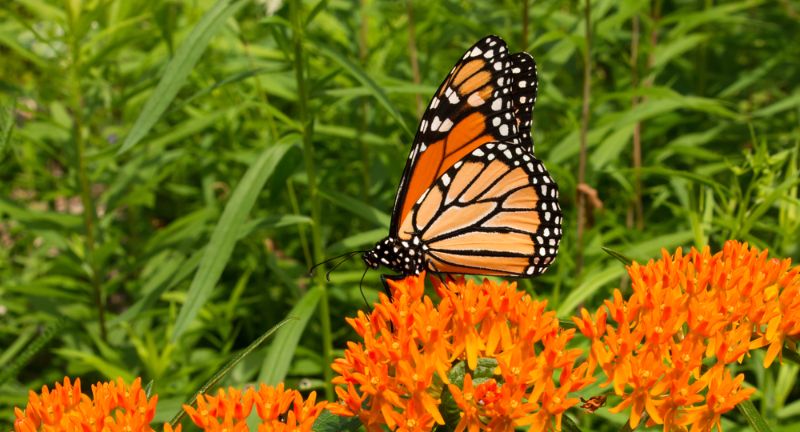
Shutterstock
The super generation of monarch butterflies is unique in that it lives up to eight months, far longer than the average monarch lifespan of 2-6 weeks. This generation is responsible for flying thousands of miles from North America to their overwintering grounds in Mexico. Unlike previous generations, they don’t reproduce immediately after reaching maturity; instead, they conserve energy for the long journey. After overwintering, these butterflies begin the northward migration in spring, starting the cycle anew.
Milkweed Diet

Shutterstock
Monarch caterpillars feed exclusively on milkweed plants, which provide them with both sustenance and defense against predators. The milkweed contains toxins called cardenolides, which make monarchs toxic to many predators. By ingesting milkweed, monarchs store these toxins in their bodies, making them distasteful and even harmful to animals that try to eat them. This unique diet is crucial for their survival, and the availability of milkweed is directly linked to the health of monarch populations.
Bright Warning Colors

Shutterstock
Monarch butterflies are easily recognized by their vibrant orange, black, and white coloring, which serves as a warning to predators. These bright colors signal that monarchs are toxic due to the milkweed they consumed as caterpillars. Predators that have previously eaten a monarch and experienced its toxicity are less likely to attack another one. This type of defense mechanism is called aposematism, where bright colors warn predators of danger.
Lifecycle Stages
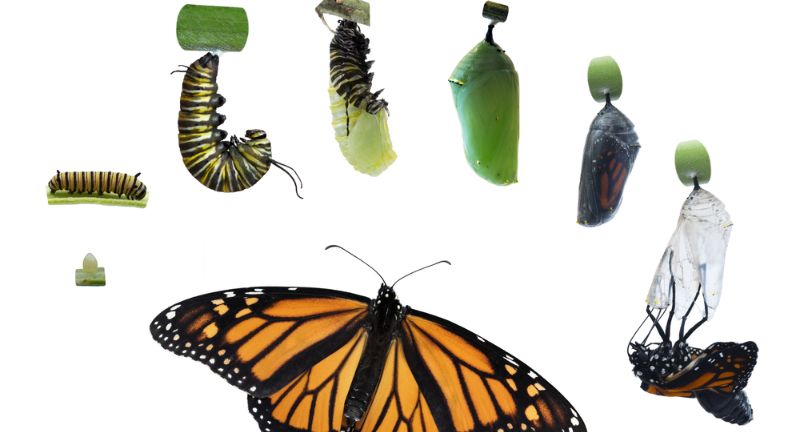
Shutterstock
Monarch butterflies go through four distinct life stages: egg, caterpillar (larva), chrysalis (pupa), and adult butterfly. Each stage plays a vital role in the butterfly’s development. The egg hatches into a caterpillar that spends its time eating and growing, eventually forming a chrysalis where it undergoes metamorphosis. After a period of transformation, the monarch emerges as a fully developed butterfly, ready to begin its migration or reproduction cycle.
Chrysalis Transformation
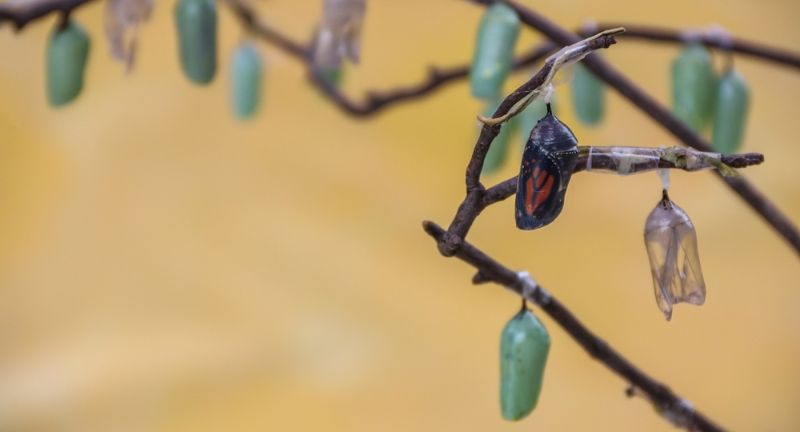
Shutterstock
During the chrysalis stage, monarch caterpillars undergo one of nature’s most remarkable transformations. Inside the chrysalis, the caterpillar breaks down into a liquid-like state and re-forms as a butterfly over 10-14 days. This process, called metamorphosis, results in the emergence of a beautiful monarch butterfly with wings ready to fly. The transformation from a crawling caterpillar to a flying butterfly is one of the most iconic changes in the insect world.
Multi-Generational Cycle

Shutterstock
The monarch butterfly’s migration involves multiple generations over the course of a year. While it takes one generation of monarchs to fly south in the fall, it takes three or four generations to complete the northward journey in spring and summer. Each new generation continues where the previous one left off, flying further north to breed before dying. This cycle repeats each year, with only the super generation making the complete migration south.
Navigational Skills
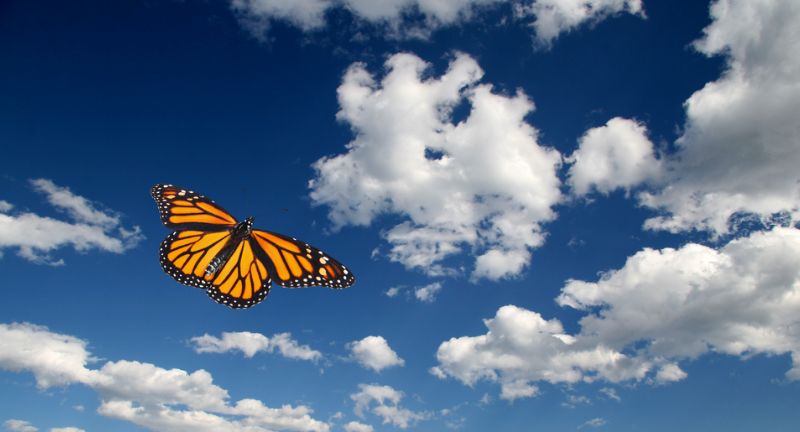
Shutterstock
Monarch butterflies have remarkable navigational abilities that guide them during their long migrations. Scientists believe that monarchs use a combination of the sun’s position, Earth’s magnetic field, and landmarks to navigate. Despite never having made the journey before, young monarchs instinctively know how to find their way to their overwintering grounds. This sophisticated sense of direction is one of nature’s great mysteries.
Wintering in Mexico
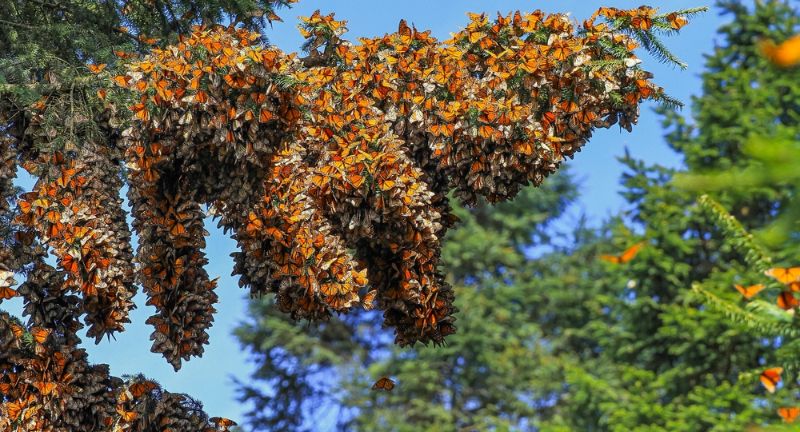
Shutterstock
Each winter, monarch butterflies from eastern North America migrate to specific forest areas in the Sierra Madre Mountains of central Mexico. These forests provide the ideal conditions for overwintering, with cool temperatures and dense tree canopies offering protection. The butterflies cluster together by the thousands on branches, creating a spectacular sight. Their annual return to these forests is a remarkable natural event and a testament to the monarch’s survival instincts.
West Coast Population
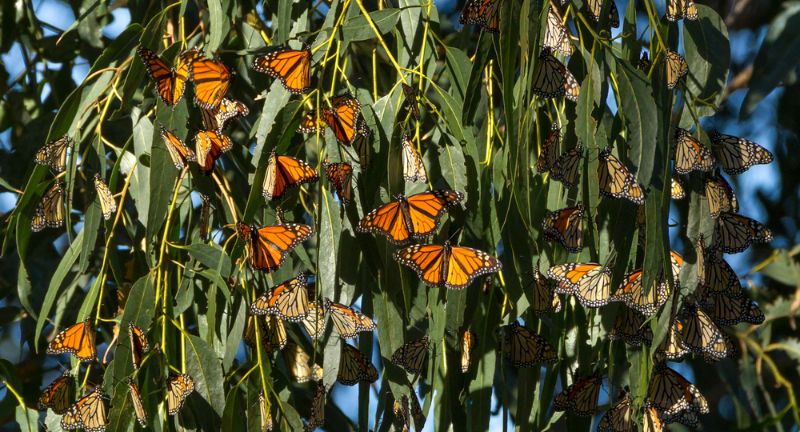
Shutterstock
Monarchs living west of the Rocky Mountains don’t make the same migration as their eastern counterparts. Instead of flying to Mexico, these monarchs migrate to the coast of California, where they overwinter in groves of eucalyptus and pine trees. Popular sites include Pacific Grove and Pismo Beach, where clusters of monarchs can be seen hanging from trees in the thousands. The milder coastal climate provides ideal conditions for their winter rest.
Pollinators
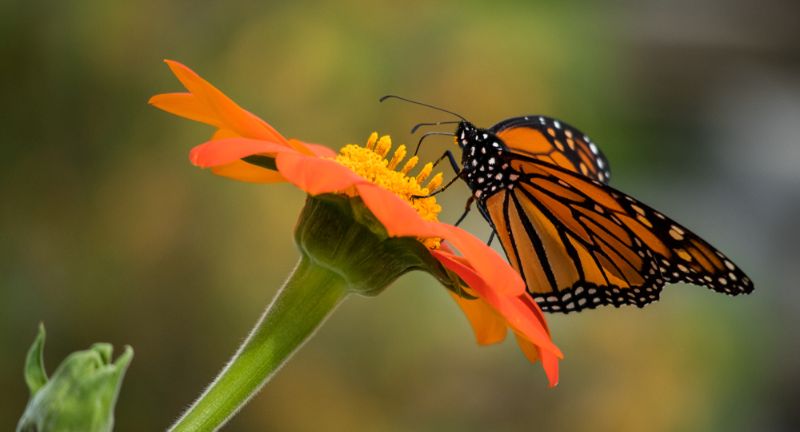
Shutterstock
Monarch butterflies play a crucial role as pollinators, helping to fertilize flowers and support plant reproduction. As they feed on nectar, they transfer pollen from one flower to another, aiding in the pollination process. While they are not as effective as bees, monarchs contribute to the biodiversity of ecosystems by supporting the growth of plants. Their role as pollinators underscores their importance in maintaining ecological balance.
Vulnerable to Climate Change

Shutterstock
Monarch butterflies are highly sensitive to changes in climate, and rising temperatures pose a significant threat to their migration patterns. Climate change can disrupt the delicate balance of temperature and weather needed for successful migration and reproduction. Warmer winters in their overwintering grounds can cause butterflies to become active too early, leading to starvation. Additionally, changing weather patterns may reduce the availability of milkweed, their primary food source.
Threatened by Habitat Loss
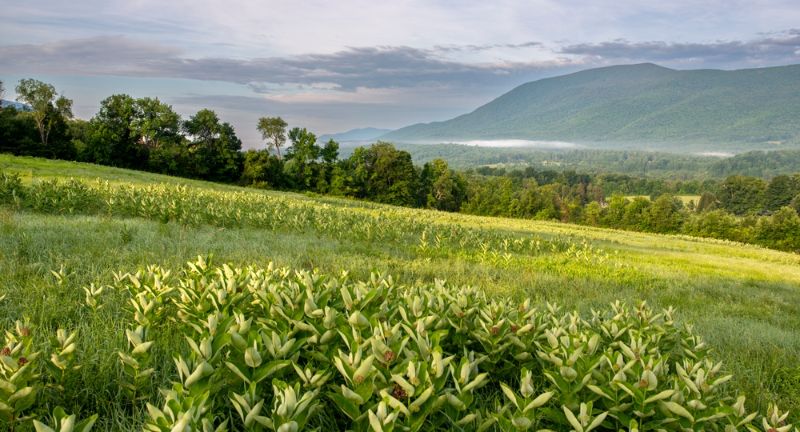
Shutterstock
Habitat loss is one of the most significant threats to monarch butterfly populations. The widespread use of herbicides and the expansion of agriculture have led to a sharp decline in milkweed plants, which are essential for monarch reproduction. Urban development and deforestation further limit the areas where monarchs can breed and overwinter. Without milkweed and suitable habitats, monarchs face declining numbers and a more uncertain future.
Monarch Watch Tagging
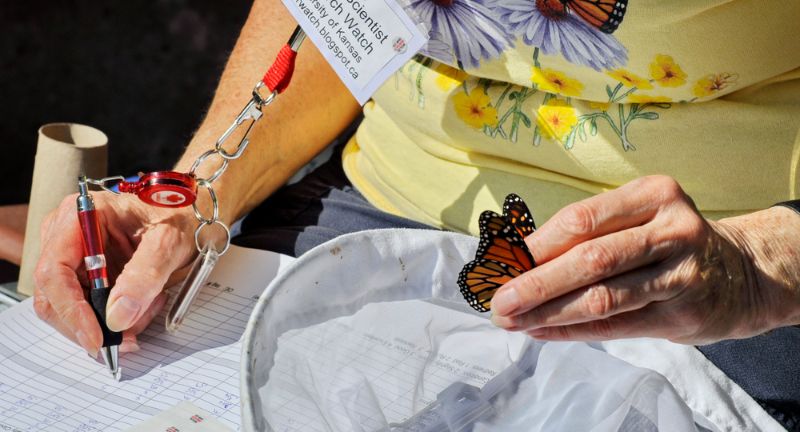
Shutterstock
Conservation organizations, such as Monarch Watch, have initiated programs to track monarch butterfly migration through tagging. Volunteers gently place small, harmless tags on the butterflies’ wings, which can later be identified if the monarch is recaptured or found. This data helps scientists understand migration patterns, population health, and survival rates. Tagging programs also raise public awareness about the challenges monarchs face and the importance of conservation.
Monarch Sanctuaries
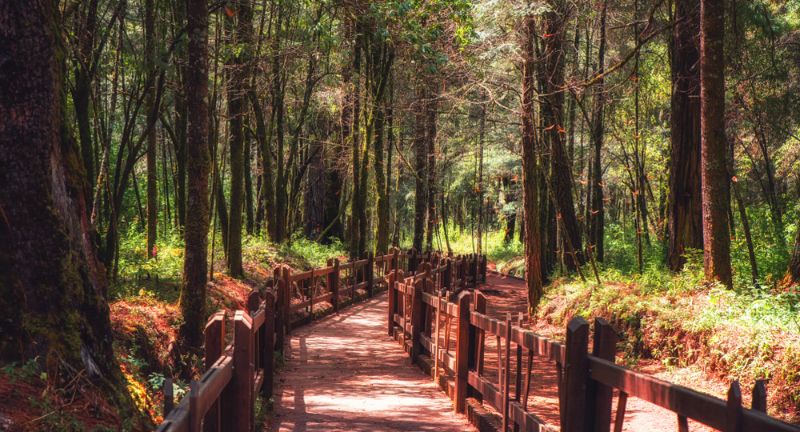
Shutterstock
The Monarch Butterfly Biosphere Reserve in Mexico is a UNESCO World Heritage Site that protects critical overwintering habitats for monarch butterflies. Millions of monarchs gather in these forest sanctuaries each winter, where they cluster on the trees to stay warm. These sanctuaries are essential for the survival of the monarch population, providing a safe environment during the cold months. Conservation efforts continue to focus on protecting these habitats from deforestation and human interference.
Ovipositing

Shutterstock
Female monarch butterflies lay their eggs on milkweed leaves, a process known as ovipositing. They are selective about where they place their eggs, often depositing them one at a time on the underside of leaves to protect them from predators. Each female can lay hundreds of eggs over her short lifespan, ensuring the continuation of the species. The survival of these eggs depends heavily on the availability of milkweed, as it is the sole food source for the emerging caterpillars.
Rapid Egg Development

Shutterstock
Monarch butterfly eggs develop rapidly, hatching in just 3 to 5 days after being laid. Once hatched, the tiny caterpillars begin feeding on the milkweed immediately, consuming large amounts to grow quickly. As they eat, they also ingest the toxic compounds in the milkweed, which protect them from predators. This rapid development allows monarch caterpillars to reach the next stage of their life cycle before they become prey to other animals or environmental factors.
Fat Storage for Migration

Shutterstock
The monarchs of the super generation store fat reserves before and during their migration to survive the long journey. These butterflies build up their fat reserves by feeding on nectar from flowers along their migration route. The stored fat not only fuels their journey but also sustains them during the winter months when food is scarce. This energy-saving strategy is crucial for their survival, enabling them to return north and reproduce when spring arrives.
Predator Avoidance

Shutterstock
Despite their toxicity, some predators, including certain species of birds and insects, have adapted to eat monarch butterflies. These predators have evolved to tolerate the toxins or avoid the most toxic parts of the butterfly. For example, black-backed orioles and black-headed grosbeaks have been observed feeding on monarchs during the winter in Mexico. This predator-prey relationship shows the adaptability of both monarchs and their natural enemies in a complex ecosystem.
Population Fluctuations

Shutterstock
Monarch butterfly populations fluctuate significantly from year to year, depending on environmental factors. Changes in weather, habitat availability, and food sources can cause monarch numbers to rise or fall dramatically. For example, a particularly harsh winter or a lack of milkweed during the breeding season can drastically reduce their population. Conservation efforts are critical in ensuring the long-term survival of monarchs amidst these fluctuations.
Wing Strength

Shutterstock
Monarch butterflies are known for their strong, resilient wings, which allow them to travel great distances during migration. Their wings are designed to be aerodynamic, enabling them to glide efficiently and conserve energy while flying. Even though monarchs weigh less than a gram, their wings are tough enough to withstand the long journey across different terrains and weather conditions. These strong wings are essential for their survival during their epic migration.
Pheromones for Mating

Shutterstock
Male monarch butterflies use special scent glands located on their hind wings to release pheromones during mating season. These pheromones attract females and play an important role in the courtship process. Once a female is interested, the male and female butterflies engage in a flight ritual before mating. This chemical communication ensures the continuation of the monarch species across generations.
Late Summer Reproduction

Shutterstock
Monarchs that emerge in late summer belong to the super generation, which differs from earlier generations in that they don’t immediately reproduce. Instead, these monarchs build up fat reserves and prepare for their long migration to overwintering sites. After surviving the winter, they begin the return journey north and reproduce the following spring. This delayed reproduction ensures the monarch population continues through the migration cycle each year.
Symbol of Conservation

Shutterstock
Monarch butterflies have become a symbol of conservation, representing the need to protect pollinators and their habitats. Conservation organizations work to raise awareness about the threats facing monarch populations, including habitat loss, climate change, and pesticide use. Monarchs serve as a reminder of the delicate balance required to maintain biodiversity. By supporting efforts to preserve their habitats, people can help ensure the survival of these iconic butterflies for generations to come.
Conclusion

Shutterstock
Monarch butterflies are a testament to the wonders of nature, displaying resilience, beauty, and remarkable instincts through their life cycle and migration. Their journey across continents and their role in pollination remind us of the delicate balance in our ecosystems. As they face growing threats from habitat loss and climate change, efforts to protect these butterflies are more crucial than ever. By preserving milkweed and other vital habitats, we can ensure future generations will continue to witness their incredible migrations. Let’s work together to protect the monarchs and the ecosystems they help sustain.
More Amazing Animals+
-


Giant panda celebrates first birthday with special cake at zoo…
-


26 Fascinating Facts About Coral Reefs
-


30 Smartest Animals In The World
-


Leatherback Turtle Hatchlings in Juno Beach, Florida
-


Lazy pooch gets paddle board tow
-


28 Creatures That Thrive in Extreme Temperatures
-


24 Wildlife Conservation Sanctuaries Around The World
-


Orphaned bear cubs playing in tree after mother bear, Bobbi,…
-


Fur Real: 25 Animals with Nature’s Thickest Coats
-


The Adorable World of Hedgehogs: 25 Things You Didn’t Know!
-


27 Animals With The Most Elaborate Hunting Strategies
-


30 Creatures With Astonishingly Loud Calls
